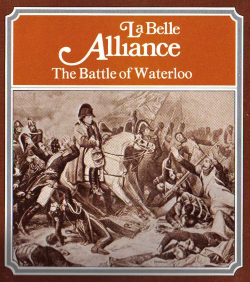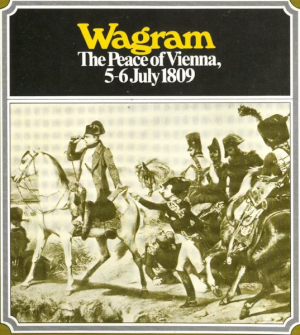
Le Grand Empire, subtitled "France and Napoleon, 1795-1815", is a strategic board wargame of conquest published by Simulations Canada in 1978 that simulates the European and global wars during the reign of Napoleon.

Le Grand Empire, subtitled "France and Napoleon, 1795-1815", is a strategic board wargame of conquest published by Simulations Canada in 1978 that simulates the European and global wars during the reign of Napoleon.
Le Grand Empire is a board wargame set in Europe, the Mediterranean and India in the late 18th century, where players representing the major European powers attempt to conquer other countries. With only seven pages of rules, it is not a complex game; designer Steve Newberg noted that it was designed to be "easy to play." [1]
Each turn represents one year, and the game lasts for twenty years. Military campaigns are dependent on an annual stipend of supplies. [2] Critic Nicky Palmer called the combat system "rudimentary": each unit involved in a combat counts as one point. Once a simple ratio of attacker to defender is established, the attacker rolls a die. Leaders Napoleon and Admiral Nelson modify the die roll. [2]
The game can be played by two players, one controlling France and the other controlling England and Austria.
All other countries are neutral, and cannot be traversed. A neutral country can be turned into an ally if a player conquers the neutral country. For two turns (two years), the victorious player can use the new ally's armies. But after two years, the ally returns to being neutral. The armies of the player who used to be an ally can now cross the neutral country, but the player no longer can use its armies (unless the player reconquers the neutral country.) [2]
The game can also be a multi-player game, with the players controlling the major European powers, much like Diplomacy .
In the two-player game, France can draw by controlling Paris and either London, Moscow or Bombay. If France can also take Alexandria, France wins. England/Austria wins by preventing a French draw or victory. [2]
Le Grand Empire was designed by Steve Newberg and published by Simulations Canada in 1978 as a ziplock bag game, with rulebook artwork by Rodger B. MacGowan. The first printing of 1000 sold out. A further printing of 500 also sold out. No further printings were made. [1]
In his 1980 book The Best of Board Wargaming , Nick Palmer didn't think France stood much of a chance in the two-player game, and predicted the unlikely course of events that would have to take place in order for France to win. Palmer thought that "The multi-player game looks more interesting than this preordained course of events, but the fun of a free-for-all erodes the historical plausibility while giving the French a better chance." Palmer concluded by giving Le Grand Empire an Excitement grade of only 40%. [2]
Strategy & Tactics thought Le Grand Empire was more of a "beer & pretzels" game, saying, "The game is pretty simple (and somewhat simplistic) and could probably be played in a long evening, depending on how many players are involved. Long on game, short on simulation." [3]
In Issue 52 of Moves , Ian Chadwick thought that the initial game set up was "poorly explained in the rules." Chadwick was also disappointed in the lack of short scenarios, saying that one long game ignored the style of warfare at the time, which had periods of intense activity, followed by months or years of relative peace. He likened the game to "France's Revolutionary Army attempting to conquer Europe. While the early game may bear some vague historical likeness, it degenerates into a mid- and endgame far removed from Napoleonic aims and warfare." Chadwick concluded by giving the game grades of "C" for Playability, "C" for Historical Accuracy, and "D" for Component Quality, saying, "The game does not live up to the designer's objectives, let alone a historical veracity. Instead of a Napoleonic game, it plays more like a slow Blitzkrieg . The game fails both as a simulation and as a game — a sad product from an otherwise good producer." [4]
In a retrospective review in Issue 10 of Simulacrum, John Kula commented, "Le Grand Empire is one of the few games that deals with the entire Napoleonic period. Unfortunately, it was a simple game released at a time when gamers were demanding ever larger and more complex simulations. Thus the fact that it was not a critical success should not be surprising, even though it was being measured against standards that clearly were not applicable. [1]

Napoleon's Last Battles is a board wargame published by Simulations Publications in 1976 that simulates the last four battles fought by Napoleon. It was one of SPI's most popular games, and also received many positive reviews.
Age of Napoleon is a 2003 war and strategy board game created in collaboration between Mayfair Games and Phalanx Games. It focuses on the Napoleonic Wars in Europe from 1805 to 1815. The game's designer is Renaud Verlaque and its artist is Franz Vohwinkel.

Napoleon at Leipzig is a board wargame published by Operational Studies Group in 1979 that simulates the Battle of Leipzig.

Arcola, The Battle for Italy 1796 is a board wargame published by Operational Studies Group (OSG) in 1979 and republished by Avalon Hill in 1983 that is a simulation of the Battle of Arcola between French and Austrian forces in 1796. The game was designed to tempt players to purchase OSG's previously published and larger wargame Napoleon in Italy.

La Grande Armée, subtitled "The Campaigns of Napoleon in Central Europe", is a board wargame published by Simulations Publications Inc. (SPI) in 1972 that simulates three campaigns of Napoleon.

Marengo: Napoleon in Italy, 14 June 1800 is a board wargame published by Simulations Publications Inc. (SPI) in 1975 as one of four games packaged together in the Napoleon at War "quadrigame". Marengo was also released as a separate game the same year. The game simulates the Battle of Marengo between Austrian and French forces.

Napoleon at Waterloo is a board wargame published by Simulations Publications Inc. (SPI) in 1971 that simulates the Battle of Waterloo. The game, which features simple rules, was designed as an introduction to board wargaming, and was given as a free gift with each subscription to SPI's Strategy & Tactics magazine.

La Belle Alliance: The Battle of Waterloo is a board wargame published by Simulations Publications Inc. (SPI) in 1976 that simulates the Battle of Waterloo in 1815. It was one of four games that were published as part of the "quadrigame" titled Napoleon's Last Battles, but was also released as an individual "folio game", packaged in a shrinkwrapped cardboard folio.

The Battle of Nations, subtitled "The Encirclement at Leipzig, 16–19 October 1813", is a board wargame published by Simulations Publications Inc. (SPI) in 1975 that simulates the Battle of Leipzig in 1813. It was one of four games that were published as part of the "quadrigame" titled Napoleon at War, but was also released as a "folio game", packaged in a shrinkwrapped cardboard folio. It was popular in a 1976 poll of favorite wargames, and critics also gave it favorable reviews.

Jena-Auerstadt: The Battle for Prussia is a board wargame published by Simulations Publications Inc. (SPI) in 1975 that simulates the twin battles of Jena and Auerstadt in October 1806. It was one of four games that were part of the "quadrigame" titled Napoleon at War, but it was also released as an individual "folio game" packaged in a shrinkwrapped cardstock folio. Jena-Auerstadt was rated highly in a 1976 poll of favorite wargames, but critics questioned whether its simplicity was capable of simulating a complicated two-part battle.

Napoleon's Last Campaigns is a board wargame published by Rand Game Associates (RGA) in 1974 that simulates the final campaigns of Napoleon in 1814 and 1815.

Quatre Bras: Stalemate on the Brussels Road is a board wargame published by Simulations Publications Inc. (SPI) in 1976 that simulates the Battle of Quatre Bras, one of the engagements leading to the Battle of Waterloo. Quatre Bras was originally published as one of four games in the popular collection Napoleon's Last Battles, but was also released as an individual game.

Ligny: Incomplete Victory is a board wargame published by Simulations Publications Inc. (SPI) in 1976 that simulates the Battle of Ligny. Ligny was originally published as one of four games in the popular collection Napoleon's Last Battles, but was also released as an individual game.

Wavre: The Opportunity Lost is a board wargame published by Simulations Publications Inc. (SPI) in 1976 that simulates the Battle of Wavre. Wavre was originally published as one of four games in the popular collection Napoleon's Last Battles, but was also released as an individual game.

Wellington in the Peninsula is a Napoleonic board wargame published by Rand Game Associates (RGA) in 1975 that simulates the Peninsular War of the early 19th century.

Strike Force One, subtitled "The Cold War Heats Up — 1975", is a board wargame published by Simulations Publications Inc. (SPI) during the Cold War in 1975 that simulates a hypothetical clash in West Germany between Soviet Union invaders, and American defenders. The short and simple game was designed as an introduction to the hobby of wargaming, and was given away as a free promotional item.

Wagram: The Peace of Vienna, 5–6 July 1809 is a board wargame published by Simulations Publications Inc. (SPI) in 1975 that simulates the Battle of Wagram in July 1809. It was one of four games that were part of the "quadrigame" titled Napoleon at War, but it was also released as an individual game with a set of metal miniatures. Wagram was rated highly in a 1976 poll of favorite wargames, and critics called it the best of the four games in the Napoleon at War box.

Napoleon's Last Triumph, subtitled "An Operational Study of The Battle of Wagram, July 1809", is a board wargame published by Simulations Canada in 1982 that simulates the Battle of Wagram in July 1809 during the War of the Fifth Coalition.

Scourge of God, subtitled "The Campaigns of the Mongolians, 1206–1259 AD", is a board wargame published by Simulations Canada in 1982 that simulates the Mongolian invasions of China, the Middle East and Europe.

Waterloo is a Napoleonic board wargame published by Avalon Hill in 1963 that simulates the Battle of Waterloo. It was one of the first board wargames produced and despite its lack of historicity and complexity, it still received positive comments more than twenty years later as a fun and playable game, and remained in Avalon Hill's catalogue until 1990.